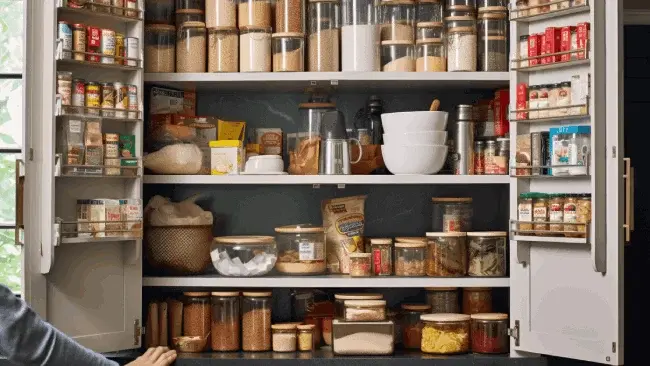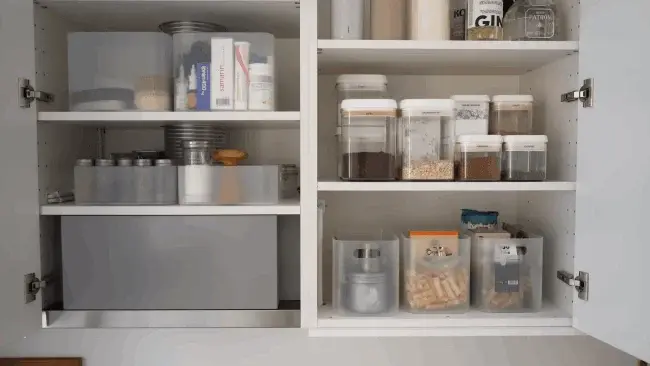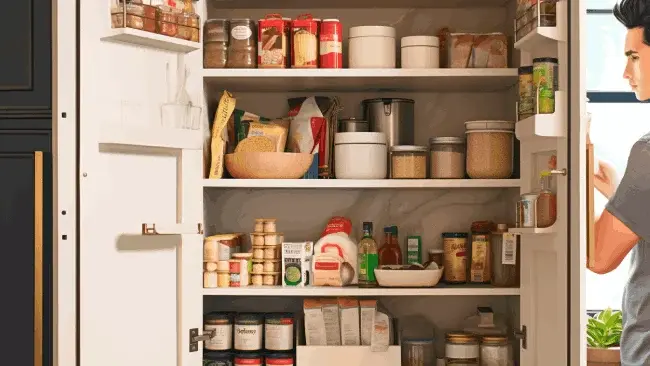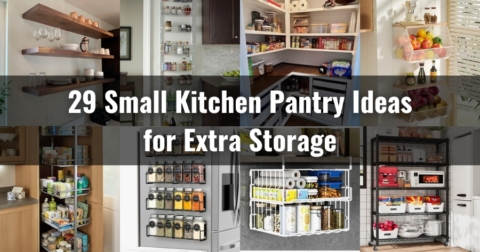Organizing your food in the kitchen cabinets can transform your daily cooking experience. A clean, well-organized cabinet where every ingredient has its place makes it a breeze to find what you need and inspires you to cook up culinary delights.
Organizing food in your kitchen cabinets starts with preparing and decluttering them. Grouping similar foods and labeling each shelf or storage area makes it easier to find them. Organizing by container size and shelf life maximizes space and prevents food waste.
We’ll talk about organizing food in your kitchen cabinets, common food organizing mistakes to avoid, and space saving strategies. So, let’s explore the art of kitchen cabinet organization and elevate your culinary experience.
How to Organize Food in Your Kitchen Cabinets: Step-By-Step Guide

For arranging food in your kitchen cabinets, there are five key steps you need to follow. Here they are:
- Step 1: Prepare and declutter the cabinets
- Step 2: Organize by food type
- Step 3: Organize by container size
- Step 4: Organize by shelf life
- Step 5: Organize by use
Let’s take a closer look at each step so that you can organize food inside your kitchen cabinets efficiently.
Step 1: Prepare and Declutter the Cabinets
Before you begin organizing your food in kitchen cabinets, we suggest starting with a clean slate and decluttering your space.
To prepare and declutter your cabinets, start by removing all items from them. This will give you a clean slate to work with. Take the opportunity to thoroughly clean the shelves thoroughly, wiping away any dust, crumbs, or residue.
As you go through the items, check for anything that is expired or stale. There’s no point in organizing things that should be thrown away. While decluttering, make a list of items you need to restock or replace so you can pick them up later when shopping.
To optimize your cabinet space effectively, consider investing in organization tools like interior drawers, clear containers, raised cabinet racks, turntables, and cork boards. These tools will help you maximize your space and keep everything organized.
Step 2: Organize by Food Type
Start by grouping similar items together into categories. You’ll need to create distinct sections for various types of food.
Consider categorizing your canned goods, sauces, cereals, pasta, rice, and grains separately. Then, designate another spot for grab-and-go snacks and one for chips, pretzels, and bagged snacks.
For all your baking endeavors, set aside a dedicated space for baking ingredients. Likewise, allocate a specific area for nuts and seeds and another for dried fruits and preserves. Remember to organize your condiments and your collection of spices and dried herbs neatly.
When you group foods of the same type together on dedicated shelves or areas in your cabinets, you can easily find what you need when cooking or preparing meals.
Our recommendation is to use clear plastic-based label tape and a label maker to identify each shelf or area clearly. This ensures consistency in your organization system and helps you quickly locate specific food categories.
Step 3: Organize by Container Size
Now, arrange items within each category by size, placing smaller items towards the front of the shelf and taller items towards the back.
By arranging your containers staggered, you can ensure that nothing gets hidden or forgotten at the back of the shelf.
Also, having smaller containers at the front allows for better visibility and accessibility, as they won’t obstruct your view or cause any inconvenience when reaching for larger items behind them.
Step 4: Organize by Shelf Life

You need to organize by shelf life to prevent food from going bad. Ensure you place items with shorter shelf lives towards the front of the shelf to ensure they are used first.
Store items with longer shelf lives, such as canned goods and pasta, towards the back. This way, they won’t be used up too quickly, and you’ll always have them on hand when needed.
Step 5: Organize by Use
Organizing by use simplifies your cooking routine and saves time. Keep items you use daily within easy reach towards the front of your cabinet.
Consider placing frequently accessed items like spices and condiments in removable containers or baskets. This makes it easier to locate items and prevents clutter.
Common Food Organizing Mistakes in Kitchen Cabinets to Avoid
When organizing your kitchen cabinets, you need to avoid common food-organizing mistakes. Here are a few:
1. Not Checking Expiry Dates
It’s easy to forget to check expiration dates when grocery shopping, but failing to do so can lead to clutter and may cause food poisoning to humans.
Not only does expired food take up valuable space in your kitchen, but it can also be harmful to eat.
Check your cabinets regularly and toss out any expired items immediately. This will make you more aware of what you have in stock and prevent any nasty surprises when preparing meals.
2. Overcrowding
Overloading your cabinets can make it challenging to see and access items. Avoid cramming too much into a single cabinet by organizing your food based on category.
For example, place all your baking supplies in one cabinet and all your canned goods in another. This will make it much easier to access what you need without having to dig through piles of clutter.
3. Storing Food in Original Packaging
Items like cereal or rice should be transferred to airtight containers to maintain freshness and prevent pests.
Storing food in its original packaging can cause it to go stale much faster, and it also makes it more likely that pests will find their way in.
Invest in a set of airtight containers and transfer all your dry goods to them as soon as you get home from the grocery store.
This will keep your food fresher for longer and prevent any unwanted visitors in your cabinets.
Space-Saving Strategies for Food Organizing in Your Kitchen Cabinets

To assist you in organizing your kitchen cabinets and maximizing space, you can use several key strategies. The following are listed:
1. Maximize Vertical Space
If you have limited cabinet space in your kitchen, making the most of vertical space is an essential strategy for organizing food.
Consider utilizing raised cabinet racks and foldable shelves to double up and make the most of this valuable spatial feature.
By increasing the number of levels for storage, you’ll be able to maximize the amount of food stored in your cabinets. This approach is especially useful for smaller cabinets where space is at a premium.
2. Lazy Susans
Deep and hard-to-reach corners can be a pain when organizing your kitchen cabinets. However, Lazy Susans are an excellent tool to help you access the items at the back of your cabinets with ease.
Simply place the Lazy Susan on your cabinet shelf, and you’ll be able to spin it around to get whatever you need in seconds.
3. Baskets and Trays
Another excellent space-saving strategy to consider for organizing your kitchen cabinets is to use baskets and trays.
These compartmentalization tools are perfect for storing loose or sticky items that tend to clutter up the cabinets. You can keep everything organized and tidy without worrying about making a mess.
4. Create a Back Stock Area
If you have limited kitchen space, creating an additional storage area outside the kitchen is an excellent space-saving strategy.
In this area, you can store backups and infrequently used items so your cabinets don’t get crowded.
You might consider a pantry or a closet that is easily accessible for these extra items. This strategy will free up space in your cabinets, allowing you to organize your everyday essential items better.
5. Consider Shallow Cabinets
Consider opting for shallow floor-to-ceiling cabinet pantries (7.5′-11′ depth) to maximize accessibility and visibility for efficient food storage in your kitchen.
These cabinets are a practical solution for organizing your food items step-by-step. With their shallow depth, you can easily see and reach everything stored inside, eliminating the need to dig through deep shelves.
Utilizing these cabinets allows you to categorize your food items effectively, making it easier to locate ingredients when cooking or meal planning. Additionally, the floor-to-ceiling design maximizes storage space while keeping everything within arm’s reach.
Conclusion
When you want to organize your food in kitchen cabinets for a more efficient and enjoyable cooking experience, remember these five essential steps.
Begin with a clean slate by preparing and decluttering your cabinets, then group similar items together by food type.
Arrange them by container size to maximize space and organize them by shelf life to prevent waste. Also, consider your daily cooking routine when organizing by use.
Avoid common food-organizing mistakes, employ space-saving strategies, and maintain freshness vigilantly.
With these steps and tips, your kitchen cabinets will become an organized and inspiring space where culinary delights are just a reach away.
FAQ’s
We discovered that many people had questions regarding the organization of food in their kitchen cabinets. You might find some of these helpful.
How to maintain food freshness in cabinets over time?
To keep your food fresh in cabinets over time, make sure to regularly check for signs of pests or spills and promptly address any issues you find.
Pests like ants, cockroaches, or rodents can contaminate your food and spread diseases. Look for droppings, chewed packaging, or tiny holes in bags as indicators of a pest infestation.
If you notice any signs, immediately clean the affected area thoroughly and use appropriate pest control methods. Also, be vigilant about spills and leaks that can attract insects or cause mold growth.
Wipe up any spills immediately and use disinfectant cleaners to prevent bacteria from proliferating.
How often should you update food organizing in cabinets for efficiency?

Based on cooking habits and storage volume, we recommend checking your cabinets on a monthly basis for efficient food organization.
During this routine, check for expired or soon-to-expire items, adjust placement of frequently used items, and ensure clear and accurate labeling. Also, optimize cabinet space for seasonal changes in your cooking.





